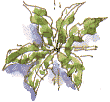 |
Beeches at BrettonMonday 11th March 2002, West Yorkshire |
![]()
![]()
![]()
![]() Rocks
History
Workshop
Links
Home Page
Rocks
History
Workshop
Links
Home Page
![]()
 A wren with nesting material in its beak flies into the thick ivy on the shed. This variegated form of ivy started as a house plant, outgrew its pot and it now covers half the shed and several panels of a larch lap fence. Its main stems are covered with a thick furry growth of rootlets so they must make a tempting place for the wren to construct its nest.
A wren with nesting material in its beak flies into the thick ivy on the shed. This variegated form of ivy started as a house plant, outgrew its pot and it now covers half the shed and several panels of a larch lap fence. Its main stems are covered with a thick furry growth of rootlets so they must make a tempting place for the wren to construct its nest. Ancient beech trees are coming to the end of their lives at Bretton Country Park. Several have been felled recently while others have been blown down in gales or shed limbs. Beeches are notorious for occasionally shedding a limb without any warning, even on a calm day.
Ancient beech trees are coming to the end of their lives at Bretton Country Park. Several have been felled recently while others have been blown down in gales or shed limbs. Beeches are notorious for occasionally shedding a limb without any warning, even on a calm day.Some years ago we counted the growth rings of a felled beech near the upper lake. It proved older than we'd expected, nearer to 200 years than 150 and therefore dating back to the last decades of the 18th century, which was about the time that the landscape park was being developed around the hall.
A month ago three large beeches were felled at Bretton Brickyard plantation at the west end of the village. They were large enough to have fallen onto the road if they had blown over in a gale. Our local naturalists' society manages a wildflower meadow at the old Brickyard. We were sorry to see these beeches go and ideally we'd have liked to leave one of their stems standing to develop as a dead wood habitat but letting the light into this small patch of woodland isn't entirely a bad thing. We will watch with interest to see what plants and wildlife move in to the newly cleared area.
 Management is essential but it has its good and bad side for wildlife. For instance there's an old stone wall on the lane leading to Bretton Hall which for years hosted a colony of hartstongue ferns. If left to its own devices I expect the wall, which supports a bank behind it, would have collapsed. It has been neatly repointed but now, of course, with cement filling all the cracks, the ferns have lost their habitat. The top of the wall still supports a colony of grey lichens.
Management is essential but it has its good and bad side for wildlife. For instance there's an old stone wall on the lane leading to Bretton Hall which for years hosted a colony of hartstongue ferns. If left to its own devices I expect the wall, which supports a bank behind it, would have collapsed. It has been neatly repointed but now, of course, with cement filling all the cracks, the ferns have lost their habitat. The top of the wall still supports a colony of grey lichens.Near the brickyard two men restore a hedge, laying back the stems to produce a stock-proof barrier.






Rooks build in tall sycamores at village end of the lane. Canada geese are gathering and pairing up in the park by the river Dearne and in the old camellia house in the grounds of the hall the camellias are at their best. Striking and elegant, they remind me of the lavish botanical illustrations of the eighteenth century.
![]()
Richard Bell,
wildlife illustrator
E-mail; 'richard@willowisland.co.uk'
![]() Next page
Previous page
This day in 2000
This month
Nature Diary
Home Page
Next page
Previous page
This day in 2000
This month
Nature Diary
Home Page
![]()